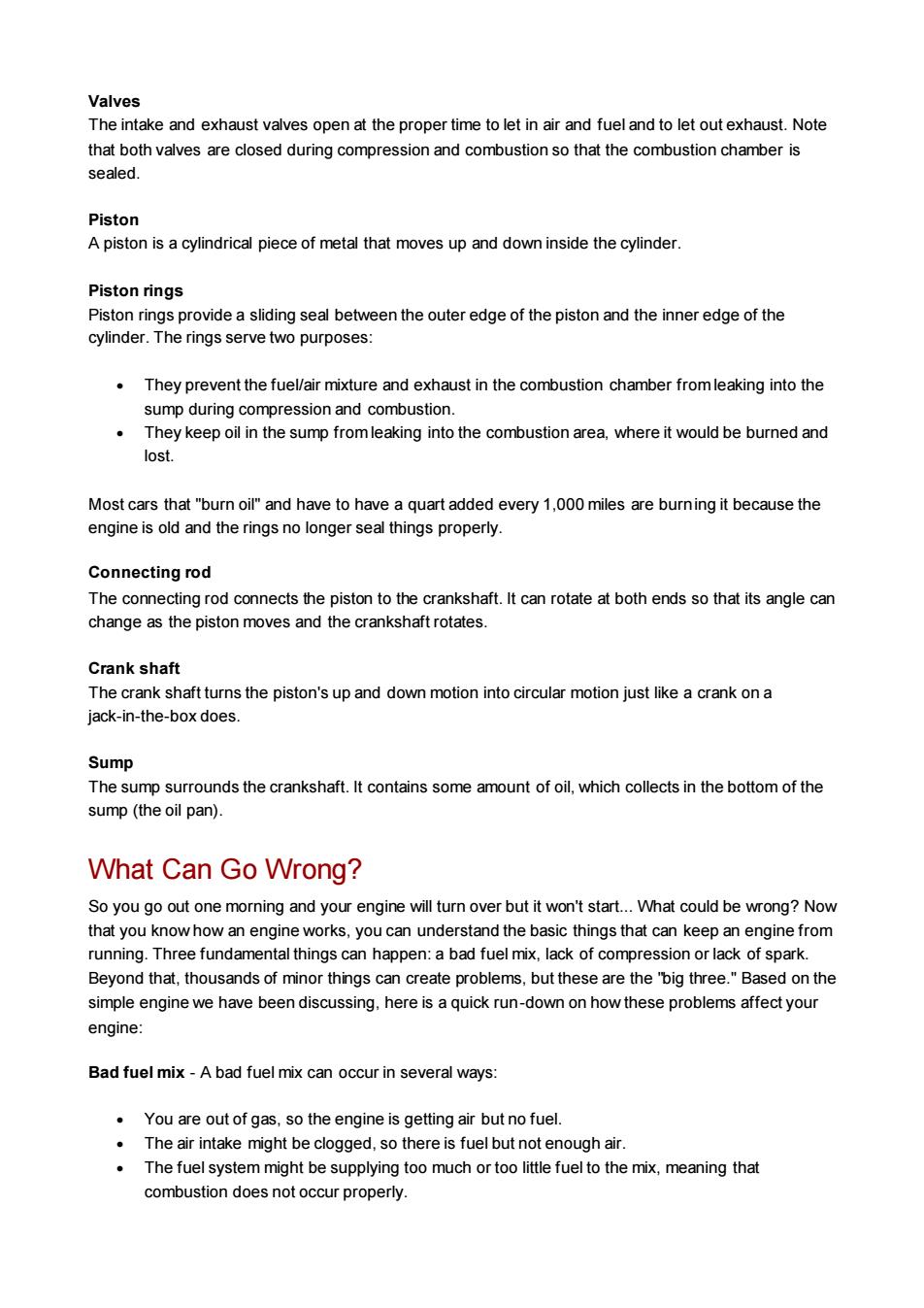
ValvesThe intake and exhaustvalvesopenat thepropertimeto let inair and fuelandto letoutexhaust.Notethat both valves are closed during compression and combustion so that the combustion chamber issealed.PistonApistonisacylindricalpieceofmetal thatmovesupanddowninsidethecylinder.PistonringsPistonringsprovideaslidingsealbetweentheouteredgeofthepistonandtheinneredgeofthecylinder.Therings servetwo purposes:Theypreventthefuel/airmixtureandexhaust inthecombustionchamberfromleakingintothesumpduringcompressionandcombustion.Theykeepoil inthesumpfromleakingintothecombustionarea,whereitwouldbeburnedandlost.Most cars that"burn oi" and have to have a quart added every1,o00 miles are burning it because theengineisoldandtheringsnolongersealthingsproperlyConnectingrodThe connectingrod connects thepiston to the crankshaft.It can rotate at both ends so that its angle canchange as thepistonmovesandthecrankshaftrotatesCrankshaftThe crank shaft turns the piston's up and down motion into circular motion just like a crank on ajack-in-the-boxdoes.SumpThe sump surrounds the crankshaft. It contains someamount ofoil, which collects in the bottom of thesump(theoilpan)What Can Go Wrong?So you go out one morning and your engine will turn over but it won't start... What could be wrong? Nowthatyouknowhowanengineworks,youcanunderstandthebasicthingsthatcankeepanenginefromrunning.Threefundamentalthingscanhappen:abadfuelmix,lack ofcompressionorlackof spark.Beyondthat,thousandsof minorthingscancreateproblems,butthesearethe"bigthree."Basedonthesimpleenginewehavebeendiscussing.hereisaquickrun-downonhowtheseproblemsaffectyourengine:Bad fuelmix-Abadfuelmix can occur in several ways:You are out of gas, so the engine is getting air but no fuel.Theair intakemightbeclogged,sothereisfuelbut notenoughair.The fuel system might be supplying too much or too litle fuel to the mix, meaning thatcombustiondoesnotoccurproperly
Valves The intake and exhaust valves open at the proper time to let in air and fuel and to let out exhaust. Note that both valves are closed during compression and combustion so that the combustion chamber is sealed. Piston A piston is a cylindrical piece of metal that moves up and down inside the cylinder. Piston rings Piston rings provide a sliding seal between the outer edge of the piston and the inner edge of the cylinder. The rings serve two purposes: • They prevent the fuel/air mixture and exhaust in the combustion chamber from leaking into the sump during compression and combustion. • They keep oil in the sump from leaking into the combustion area, where it would be burned and lost. Most cars that "burn oil" and have to have a quart added every 1,000 miles are burning it because the engine is old and the rings no longer seal things properly. Connecting rod The connecting rod connects the piston to the crankshaft. It can rotate at both ends so that its angle can change as the piston moves and the crankshaft rotates. Crank shaft The crank shaft turns the piston's up and down motion into circular motion just like a crank on a jack-in-the-box does. Sump The sump surrounds the crankshaft. It contains some amount of oil, which collects in the bottom of the sump (the oil pan). What Can Go Wrong? So you go out one morning and your engine will turn over but it won't start. What could be wrong? Now that you know how an engine works, you can understand the basic things that can keep an engine from running. Three fundamental things can happen: a bad fuel mix, lack of compression or lack of spark. Beyond that, thousands of minor things can create problems, but these are the "big three." Based on the simple engine we have been discussing, here is a quick run-down on how these problems affect your engine: Bad fuel mix - A bad fuel mix can occur in several ways: • You are out of gas, so the engine is getting air but no fuel. • The air intake might be clogged, so there is fuel but not enough air. • The fuel system might be supplying too much or too little fuel to the mix, meaning that combustion does not occur properly
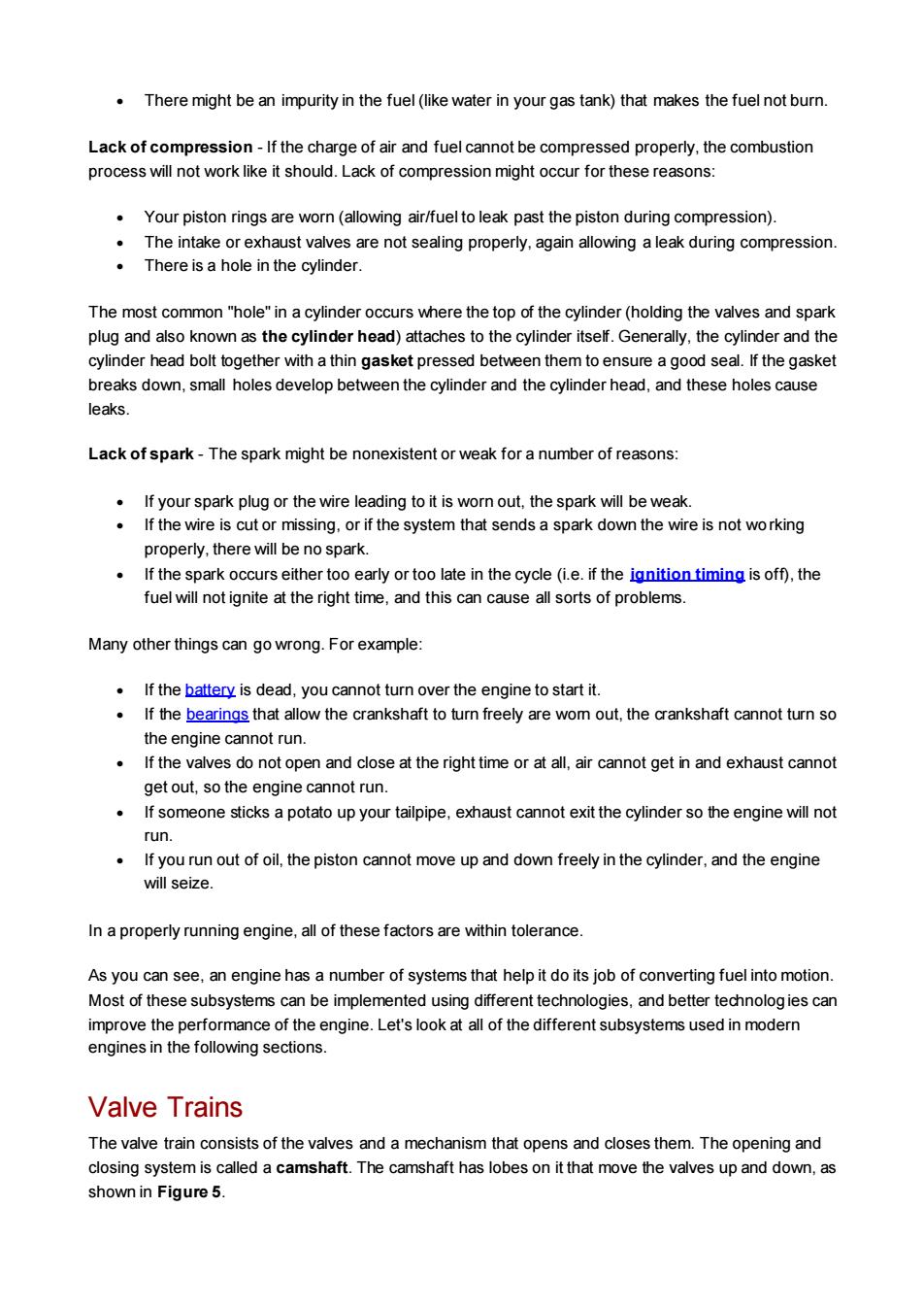
There might be an impurity in the fuel (like water in your gas tank) that makes thefuel not burn.Lackofcompression-Ifthechargeofairandfuelcannotbecompressedproperly,thecombustionprocesswillnotworklikeitshould.LackofcompressionmightoccurforthesereasonsYour piston rings are worn (allowing air/fuelto leak past the piston during compression).The intake or exhaust valves are not sealing properly,again allowing a leak during compression.Thereisahole inthe cylinder.The most common"hole"in a cylinderoccurswherethetop of thecylinder (holding the valves and sparkplugandalsoknownasthecylinderhead)attachestothecylinder itself.Generally,thecylinderandthecylinder head bolt together with a thin gasket pressed between them to ensure a good seal. If the gasketbreaksdown,small holesdevelopbetweenthecylinderandthecylinderheadandtheseholescauseleaks.Lackofspark-ThesparkmightbenonexistentorweakforanumberofreasonsIf your spark plug or thewire leadingto it isworn out,thespark will beweak.If the wire is cut or missing,or if the systemthat sends a spark down the wire is not workingproperly,there will be no spark.If the spark occurs either too early or too late in the cycle (i.e. if the ignition timing is off), thefuel will not ignite at the right time, and this can cause all sorts of problems.Manyotherthingscangowrong.Forexample:If thebattery isdead,youcannot turnovertheenginetostart it.If thebearingsthatallowthecrankshafttoturnfreelyarewomout,thecrankshaftcannotturn sothe engine cannot run.If the valves do not open and close at the right time or at all, air cannot get in and exhaust cannotgetout,sotheenginecannotrunIfsomeonesticksapotatoupyourtailpipe,exhaustcannotexitthecylindersotheenginewillnotrun.If you run out of oil, thepistoncannot move upand down freely in the cylinder,and the enginewill seize.Inaproperlyrunningengine,all ofthesefactorsarewithintoleranceAsyoucansee,anenginehasanumberofsystemsthathelpitdoitsjobofconvertingfuelintomotionMost of these subsystems canbe implementedusing differenttechnologies,andbettertechnologies canimprovetheperformanceoftheengine.Let'slookatall ofthedifferentsubsystemsusedinmodernenginesinthefollowingsectionsValve TrainsThe valve train consists of the valves and a mechanism that opens and closes them. The opening andclosingsystemiscalledacamshaft.Thecamshafthas lobeson itthatmovethevalvesupanddown,asshown in Figure 5
• There might be an impurity in the fuel (like water in your gas tank) that makes the fuel not burn. Lack of compression - If the charge of air and fuel cannot be compressed properly, the combustion process will not work like it should. Lack of compression might occur for these reasons: • Your piston rings are worn (allowing air/fuel to leak past the piston during compression). • The intake or exhaust valves are not sealing properly, again allowing a leak during compression. • There is a hole in the cylinder. The most common "hole" in a cylinder occurs where the top of the cylinder (holding the valves and spark plug and also known as the cylinder head) attaches to the cylinder itself. Generally, the cylinder and the cylinder head bolt together with a thin gasket pressed between them to ensure a good seal. If the gasket breaks down, small holes develop between the cylinder and the cylinder head, and these holes cause leaks. Lack of spark - The spark might be nonexistent or weak for a number of reasons: • If your spark plug or the wire leading to it is worn out, the spark will be weak. • If the wire is cut or missing, or if the system that sends a spark down the wire is not working properly, there will be no spark. • If the spark occurs either too early or too late in the cycle (i.e. if the ignition timing is off), the fuel will not ignite at the right time, and this can cause all sorts of problems. Many other things can go wrong. For example: • If the battery is dead, you cannot turn over the engine to start it. • If the bearings that allow the crankshaft to turn freely are worn out, the crankshaft cannot turn so the engine cannot run. • If the valves do not open and close at the right time or at all, air cannot get in and exhaust cannot get out, so the engine cannot run. • If someone sticks a potato up your tailpipe, exhaust cannot exit the cylinder so the engine will not run. • If you run out of oil, the piston cannot move up and down freely in the cylinder, and the engine will seize. In a properly running engine, all of these factors are within tolerance. As you can see, an engine has a number of systems that help it do its job of converting fuel into motion. Most of these subsystems can be implemented using different technologies, and better technolog ies can improve the performance of the engine. Let's look at all of the different subsystems used in modern engines in the following sections. Valve Trains The valve train consists of the valves and a mechanism that opens and closes them. The opening and closing system is called a camshaft. The camshaft has lobes on it that move the valves up and down, as shown in Figure 5
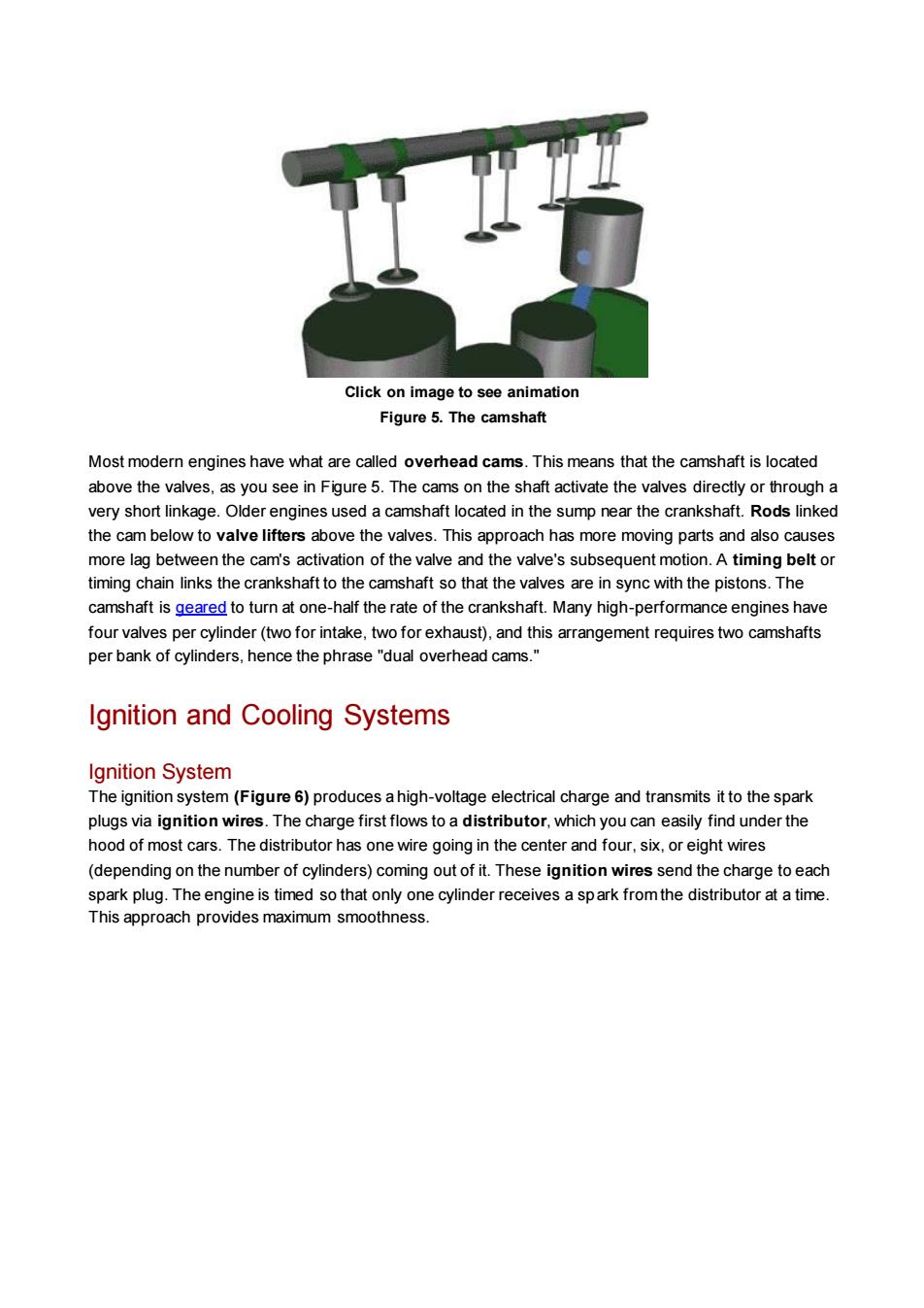
ClickonimagetoseeanimationFigure5.ThecamshaftMostmodernengineshavewhatarecalledoverheadcams.Thismeansthatthecamshaftislocatedabovethevalves,asyousee inFigure5.Thecamsontheshaftactivatethevalvesdirectlyorthroughaveryshort linkage.Olderenginesusedacamshaftlocatedinthesumpnearthecrankshaft.Rodslinkedthecambelowtovalveliftersabovethevalves.Thisapproachhasmoremovingpartsandalsocausesmorelagbetweenthe cam's activation of thevalveand thevalve's subsequentmotion.Atimingbeltortimingchain linksthecrankshafttothecamshaft sothatthevalvesareinsyncwiththepistons.Thecamshaft isgearedtoturnatone-halftherateofthecrankshaft.Manyhigh-performanceengineshavefour valves per cylinder (two for intake, two for exhaust), and this arrangement requires two camshaftsperbank of cylinders,hence the phrase"dual overhead cams."IgnitionandCoolingSvstemsIgnitionSystemTheignitionsystem(Figure6)producesahigh-voltageelectrical chargeandtransmits ittothesparkplugsvia ignitionwires.Thechargefirstflowstoadistributor,whichyoucan easilyfindunderthehoodofmost cars.Thedistributor has onewiregoing in thecenterandfour,six,oreight wires(dependingonthenumberof cylinders)comingoutofit.Theseignitionwiressendthechargetoeachsparkplug.TheengineistimedsothatonlyonecylinderreceivesasparkfromthedistributoratatimeThisapproachprovidesmaximumsmoothness
Click on image to see animation Figure 5. The camshaft Most modern engines have what are called overhead cams. This means that the camshaft is located above the valves, as you see in Figure 5. The cams on the shaft activate the valves directly or through a very short linkage. Older engines used a camshaft located in the sump near the crankshaft. Rods linked the cam below to valve lifters above the valves. This approach has more moving parts and also causes more lag between the cam's activation of the valve and the valve's subsequent motion. A timing belt or timing chain links the crankshaft to the camshaft so that the valves are in sync with the pistons. The camshaft is geared to turn at one-half the rate of the crankshaft. Many high-performance engines have four valves per cylinder (two for intake, two for exhaust), and this arrangement requires two camshafts per bank of cylinders, hence the phrase "dual overhead cams." Ignition and Cooling Systems Ignition System The ignition system (Figure 6) produces a high-voltage electrical charge and transmits it to the spark plugs via ignition wires. The charge first flows to a distributor, which you can easily find under the hood of most cars. The distributor has one wire going in the center and four, six, or eight wires (depending on the number of cylinders) coming out of it. These ignition wires send the charge to each spark plug. The engine is timed so that only one cylinder receives a spark from the distributor at a time. This approach provides maximum smoothness
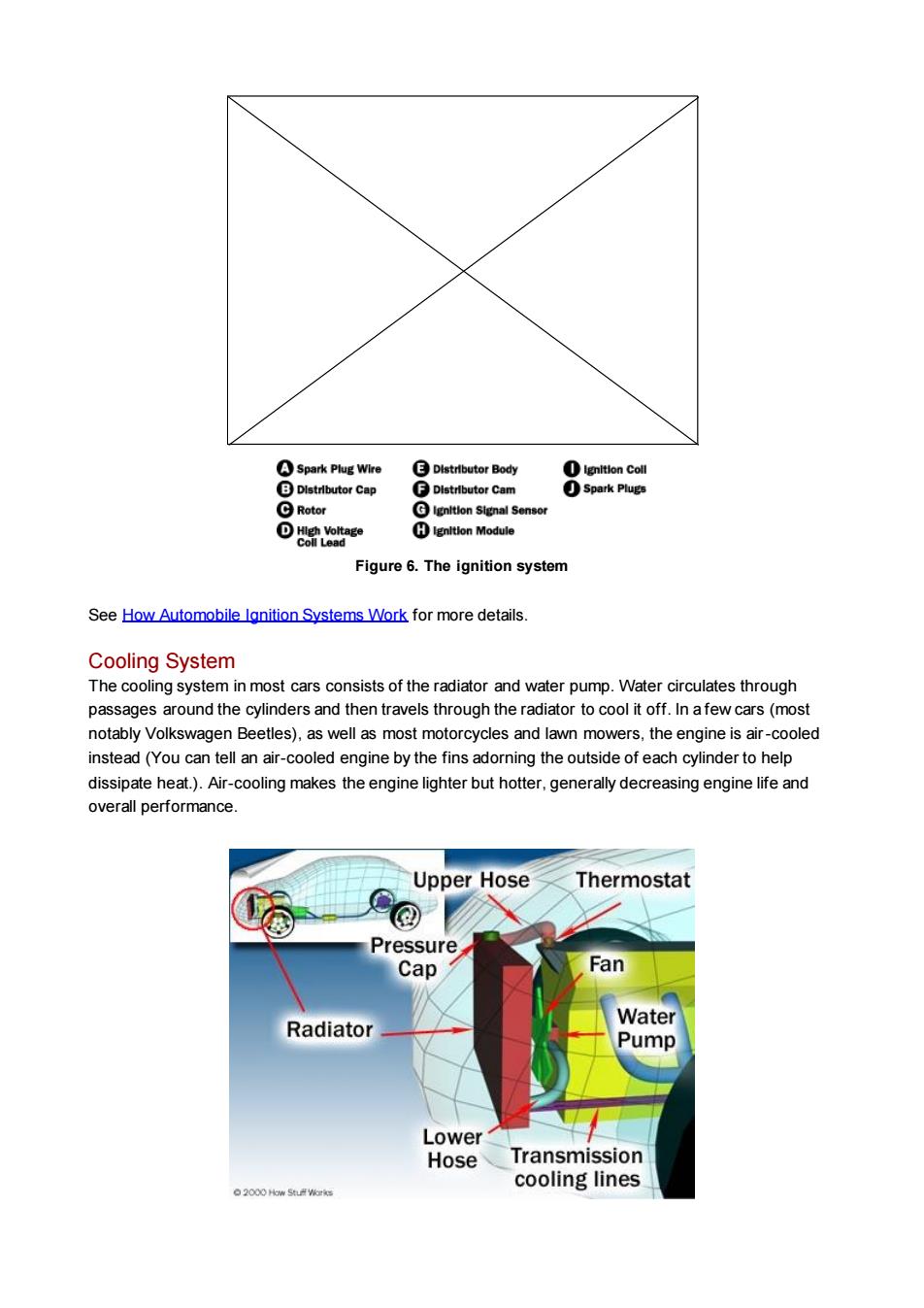
Spark Plug WireDlstrlbutor BodlyOignition CollBDlstrlbutor CapDistrlbutor CamOSpark PlugsCRotorignition Signal SensorOHlghVoltageIignltion ModulenAaCFigure6.TheignitionsystemSeeHowAutomobilelgnitionSystemsWorkformoredetails.Cooling SystemThe cooling system in most cars consists of the radiator and water pump. Water circulates throughpassages around the cylinders and then travels through the radiator to cool it off. In afew cars (mostnotablyVolkswagenBeetles),aswellasmostmotorcyclesandlawnmowers,theengineisair-cooledinstead (Youcantell anair-cooledenginebythefinsadorningtheoutsideofeachcylindertohelpdissipateheat.).Air-coolingmakestheenginelighterbuthotter,generallydecreasingenginelifeandoverallperformanceUpper HoseThermostat3PressureFanCapWaterRadiatorPumpLowerTransmissionHosecooling linesO.2000HowStufWorks
Figure 6. The ignition system See How Automobile Ignition Systems Work for more details. Cooling System The cooling system in most cars consists of the radiator and water pump. Water circulates through passages around the cylinders and then travels through the radiator to cool it off. In a few cars (most notably Volkswagen Beetles), as well as most motorcycles and lawn mowers, the engine is air-cooled instead (You can tell an air-cooled engine by the fins adorning the outside of each cylinder to help dissipate heat.). Air-cooling makes the engine lighter but hotter, generally decreasing engine life and overall performance
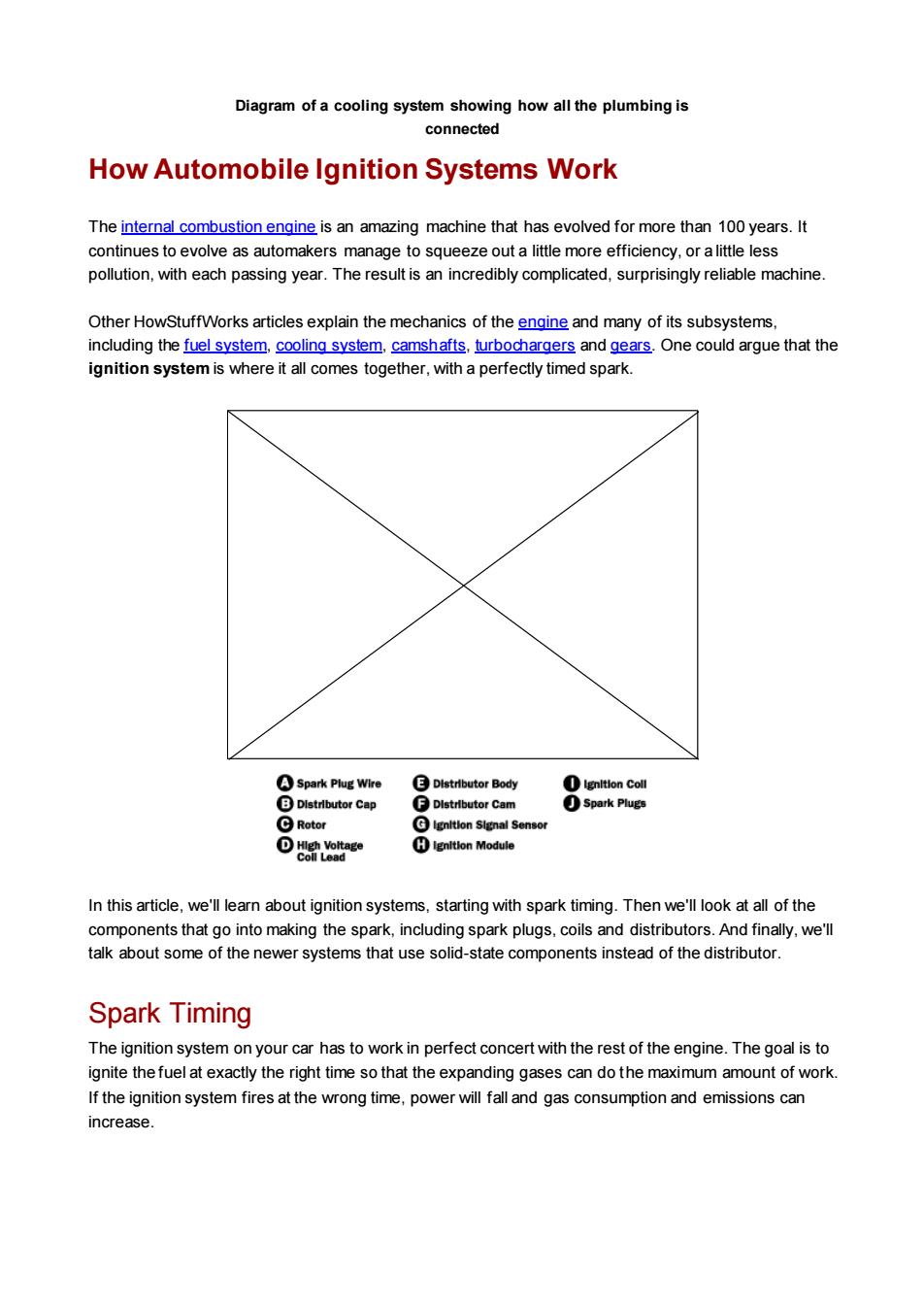
DiagramofacoolingsystemshowinghowalltheplumbingisconnectedHowAutomobilelgnitionSystemsWorkThe internal combustion engine is an amazing machine that has evolved for more than 1oo years. Itcontinuestoevolveas automakersmanageto squeezeouta littlemore efficiency,oralittlelesspollution,witheachpassingyear.Theresultisanincrediblycomplicated,surprisinglyreliablemachine.OtherHowStuffWorksarticlesexplainthemechanicsoftheengineandmanyofitssubsystemsincluding the fuel system, cooling system, camshafts, turbochargers and gears. One could argue that theignition system is where it all comes together,with a perfectly timed spark.ASpark Plug WireDistrlbutor BoclyOigntion CollBDistrlbutor CapCDistributor CamOSparkPlugsCRotorIgnltlon Slgnal SensorOHlgh Voltageignition ModuleColl LeadInthisarticlewe'll learn about ignition systems,startingwith spark timing.Thenwe'll look at all ofthecomponentsthatgointomakingthespark,includingsparkplugs,coilsanddistributors.Andfinally,we'lltalkaboutsomeofthenewersystemsthat usesolid-statecomponents insteadof thedistributor.Spark TimingTheignitionsystemonyourcarhastoworkinperfect concertwiththerestoftheengine.Thegoal istoignitethefuelat exactlytherighttimesothat theexpandinggases can dothemaximumamountofwork.If the ignition system fires at the wrong time, power will falland gas consumption and emissions canincrease
Diagram of a cooling system showing how all the plumbing is connected How Automobile Ignition Systems Work The internal combustion engine is an amazing machine that has evolved for more than 100 years. It continues to evolve as automakers manage to squeeze out a little more efficiency, or a little less pollution, with each passing year. The result is an incredibly complicated, surprisingly reliable machine. Other HowStuffWorks articles explain the mechanics of the engine and many of its subsystems, including the fuel system, cooling system, camshafts, turbochargers and gears. One could argue that the ignition system is where it all comes together, with a perfectly timed spark. In this article, we'll learn about ignition systems, starting with spark timing. Then we'll look at all of the components that go into making the spark, including spark plugs, coils and distributors. And finally, we'll talk about some of the newer systems that use solid-state components instead of the distributor. Spark Timing The ignition system on your car has to work in perfect concert with the rest of the engine. The goal is to ignite the fuel at exactly the right time so that the expanding gases can do the maximum amount of work. If the ignition system fires at the wrong time, power will fall and gas consumption and emissions can increase